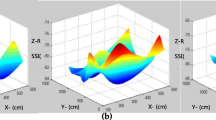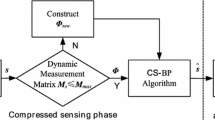Abstract
Localization based on fingerprint has been viewed as a popular indoor localization technique, which uses the signal strength of different positions as the location fingerprint. The localization model can thus be constructed by analyzing the relationship between the location fingerprint and the target location. However, this method requires the manual acquisition of fingerprint signal data in an offline phase, which has become a bottleneck for practical application, especially in large-scale fields. Therefore, how to reduce the workload in fingerprint collection has become a significant issue. This paper invokes a compressive sensing-based method to reduce fingerprint construction complexity. First, the k-singular value decomposition algorithm based on an overcomplete dictionary is employed to sparse the fingerprint signal. Then, considering the uncertainty of the signal sparsity in the indoor environment, an adaptive fingerprint signal reconstruction algorithm based on error weight is proposed to construct signals with variable sparsity. We test the proposed fingerprint reconstruction on both actual RSSI and geomagnetic fingerprints. Experiments show that the fingerprint database of 132 reference positions can be reconstructed with only 50 compressed samples, which reduces the workload of offline collection by 62\(\%\).












Similar content being viewed by others
References
Xie, Y., Wang, Y., Nallanathan, A., & Wang, L. (2016). An improved k-nearest-neighbor indoor localization method based on spearman distance. IEEE Signal Processing Letters, 23(3), 351–355. https://doi.org/10.1109/LSP.2016.2519607
Khatab, Z. E., Hajihoseini, A., & Ghorashi, S. A. (2018). A fingerprint method for indoor localization using autoencoder based deep extreme learning machine. IEEE Sensors Letters, 2(1), 1–4. https://doi.org/10.1109/LSENS.2017.2787651
Zhang, Y., Zhu, Y., Lu, M., & Chen, A. (2013). Using compressive sensing to reduce fingerprint collection for indoor localization. In 2013 IEEE wireless communications and networking conference (WCNC) (pp. 4540–4545). https://doi.org/10.1109/WCNC.2013.6555310
He, S., Chan, S.-H.G., Yu, L., & Liu, N. (2019). Maxlifd: Joint maximum likelihood localization fusing fingerprints and mutual distances. IEEE Transactions on Mobile Computing, 18(3), 602–617. https://doi.org/10.1109/TMC.2018.2841842
Donoho, D. L. (2006). Compressed sensing. IEEE Transactions on Information Theory, 52(4), 1289–1306. https://doi.org/10.1109/TIT.2006.871582
Kim, B., & Kong, S.-H. (2016). A novel indoor positioning technique using magnetic fingerprint difference. IEEE Transactions on Instrumentation and Measurement, 65(9), 2035–2045. https://doi.org/10.1109/TIM.2016.2566759
Zhou, C., Liu, J., Sheng, M., Zheng, Y., & Li, J. (2021). Exploiting fingerprint correlation for fingerprint-based indoor localization: A deep learning based approach. IEEE Transactions on Vehicular Technology, 70(6), 5762–5774. https://doi.org/10.1109/TVT.2021.3075539
Liu, X.-Y., & Wang, X. (2021). Real-time indoor localization for smartphones using tensor-generative adversarial nets. IEEE Transactions on Neural Networks and Learning Systems, 32(8), 3433–3443. https://doi.org/10.1109/TNNLS.2020.3010724
Ma, L., Zhang, Y., & Qin, D. (2022). A novel indoor fingerprint localization system based on distance metric learning and ap selection. IEEE Transactions on Instrumentation and Measurement, 71, 1–15. https://doi.org/10.1109/TIM.2021.3126014
Faragher, R., & Harle, R. (2015). Location fingerprinting with bluetooth low energy beacons. IEEE Journal on Selected Areas in Communications, 33(11), 2418–2428. https://doi.org/10.1109/JSAC.2015.2430281
Xia, H., Zuo, J., Liu, S., & Qiao, Y. (2019). Indoor localization on smartphones using built-in sensors and map constraints. IEEE Transactions on Instrumentation and Measurement, 68(4), 1189–1198. https://doi.org/10.1109/TIM.2018.2863478
Chen, Z., Zhu, Q., & Soh, Y. C. (2016). Smartphone inertial sensor-based indoor localization and tracking with iBeacon corrections. IEEE Transactions on Industrial Informatics, 12(4), 1540–1549. https://doi.org/10.1109/TII.2016.2579265
He, S., & Chan, S.-H.G. (2016). Tilejunction: Mitigating signal noise for fingerprint-based indoor localization. IEEE Transactions on Mobile Computing, 15(6), 1554–1568. https://doi.org/10.1109/TMC.2015.2463287
Feng, C., Au, W. S. A., Valaee, S., & Tan, Z. (2012). Received-signal-strength-based indoor positioning using compressive sensing. IEEE Transactions on Mobile Computing, 11(12), 1983–1993. https://doi.org/10.1109/TMC.2011.216
Dinh, T.-M.T., Duong, N.-S., & Sandrasegaran, K. (2020). Smartphone-based indoor positioning using BLE iBeacon and reliable lightweight fingerprint map. IEEE Sensors Journal, 20(17), 10283–10294. https://doi.org/10.1109/JSEN.2020.2989411
Zuo, J., Liu, S., Xia, H., & Qiao, Y. (2018). Multi-phase fingerprint map based on interpolation for indoor localization using iBeacons. IEEE Sensors Journal, 18(8), 3351–3359. https://doi.org/10.1109/JSEN.2018.2789431
Zhao, H., Huang, B., & Jia, B. (2016). Applying kriging interpolation for WiFi fingerprinting based indoor positioning systems. In IEEE wireless communications and networking conference WCNC (pp. 1–6). https://doi.org/10.1109/WCNC.2016.7565018
Yeh, S.-C., Hsu, W.-H., Lin, W.-Y., & Wu, Y.-F. (2020). Study on an indoor positioning system using Earth’s magnetic field. IEEE Transactions on Instrumentation and Measurement, 69(3), 865–872. https://doi.org/10.1109/TIM.2019.2905750
Lin, K., Chen, M., Deng, J., Hassan, M. M., & Fortino, G. (2016). Enhanced fingerprinting and trajectory prediction for IoT localization in smart buildings. IEEE Transactions on Automation Science and Engineering, 13(3), 1294–1307. https://doi.org/10.1109/TASE.2016.2543242
Guo, X., Li, L., Ansari, N., & Liao, B. (2018). Accurate WiFi localization by fusing a group of fingerprints via a global fusion profile. IEEE Transactions on Vehicular Technology, 67(8), 7314–7325. https://doi.org/10.1109/TVT.2018.2833029
Luo, J., Zhang, Z., Wang, C., Liu, C., & Xiao, D. (2019). Indoor multifloor localization method based on WiFi fingerprints and LDA. IEEE Transactions on Industrial Informatics, 15(9), 5225–5234. https://doi.org/10.1109/TII.2019.2912055
Zhang, S., Liu, K., Zhang, Y., & Wang, Y. (2022). A coarse fingerprint-assisted multiple target indoor device-free localization with visible light sensing. IEEE Sensors Journal, 22(2), 1461–1473. https://doi.org/10.1109/JSEN.2021.3130711
Sun, W., Xue, M., Yu, H., Tang, H., & Lin, A. (2018). Augmentation of fingerprints for indoor WiFi localization based on Gaussian process regression. IEEE Transactions on Vehicular Technology, 67(11), 10896–10905. https://doi.org/10.1109/TVT.2018.2870160
Li, L., Wen, G., Wang, Z., & Yang, Y. (2020). Efficient and secure image communication system based on compressed sensing for IoT monitoring applications. IEEE Transactions on Multimedia, 22(1), 82–95. https://doi.org/10.1109/TMM.2019.2923111
Sun, Y., Chen, J., Liu, Q., Liu, B., & Guo, G. (2020). Dual-path attention network for compressed sensing image reconstruction. IEEE Transactions on Image Processing, 29, 9482–9495. https://doi.org/10.1109/TIP.2020.3023629
Zhiyuan, S., Qianqian, W., & Xinmiao, C. (2021). A sparsity adaptive compressed signal reconstruction based on sensing dictionary. Journal of Systems Engineering and Electronics, 32(6), 1345–1353. https://doi.org/10.23919/JSEE.2021.000114
Fu, W., Lu, T., & Li, S. (2020). Context-aware compressed sensing of hyperspectral image. IEEE Transactions on Geoscience and Remote Sensing, 58(1), 268–280. https://doi.org/10.1109/TGRS.2019.2936229
Fu, H., & Chi, Y. (2018). Quantized spectral compressed sensing: Cramer–Rao bounds and recovery algorithms. IEEE Transactions on Signal Processing, 66(12), 3268–3279. https://doi.org/10.1109/TSP.2018.2827326
Hwang, W., Huang, P., Kung, B., Ho, J., & Jong, T. (2019). Frame-based sparse analysis and synthesis signal representations and parseval K-SVD. IEEE Transactions on Signal Processing, 67(12), 3330–3343. https://doi.org/10.1109/TSP.2019.2916105
De, P., Chatterjee, A., & Rakshit, A. (2021). Regularized K-SVD-based dictionary learning approaches for PIR sensor-based detection of human movement direction. IEEE Sensors Journal, 21(5), 6459–6467. https://doi.org/10.1109/JSEN.2020.3040228
Zeng, M., & Chen, Z. (2020). SOSO boosting of the K-SVD denoising algorithm for enhancing fault-induced impulse responses of rolling element bearings. IEEE Transactions on Industrial Electronics, 67(2), 1282–1292. https://doi.org/10.1109/TIE.2019.2898583
Qin, Y., Zou, J., Tang, B., Wang, Y., & Chen, H. (2020). Transient feature extraction by the improved orthogonal matching pursuit and K-SVD algorithm with adaptive transient dictionary. IEEE Transactions on Industrial Informatics, 16(1), 215–227. https://doi.org/10.1109/TII.2019.2909305
Raja, H., & Bajwa, W. U. (2016). Cloud K-SVD: A collaborative dictionary learning algorithm for big, distributed data. IEEE Transactions on Signal Processing, 64(1), 173–188. https://doi.org/10.1109/TSP.2015.2472372
Chen, J., Jia, J., Deng, Y., Wang, X., & Aghvami, A. (2018). Adaptive compressive sensing and data recovery for periodical monitoring wireless sensor networks. Sensors, 18(10), 3369. https://doi.org/10.3390/s18103369
Aharon, M., Elad, M., & Bruckstein, A. (2006). K-SVD: An algorithm for designing overcomplete dictionaries for sparse representation. IEEE Transactions on Signal Processing, 54(11), 4311–4322. https://doi.org/10.1109/TSP.2006.881199
Chen, S. S., & Saunders, D. M. A. (2001). Atomic decomposition by basis pursuit. SIAM Review, 43(1), 129–159.
Sahoo, S. K., & Makur, A. (2015). Signal recovery from random measurements via extended orthogonal matching pursuit. IEEE Transactions on Signal Processing, 63(10), 2572–2581.
Wu, H., & Wang, S. (2012). Adaptive sparsity matching pursuit algorithm for sparse reconstruction. IEEE Signal Processing Letters, 19(8), 471–474. https://doi.org/10.1109/LSP.2012.2188793
Rubinstein, R., Peleg, T., & Elad, M. (2013). Analysis K-SVD: A dictionary-learning algorithm for the analysis sparse model. IEEE Transactions on Signal Processing, 61(3), 661–677. https://doi.org/10.1109/TSP.2012.2226445
Mao, K., Zhu, Q., Song, M., Li, H., Ning, B., Pedersen, G. F., & Fan, W. (2022). Machine learning-based 3D channel modeling for U2V mmWave communications. IEEE Internet of Things Journal, 9(18), 17592–17607. https://doi.org/10.1109/JIOT.2022.3155773
Acknowledgements
This work was supported in part by the National Natural Science Foundation of China under Grants Nos. 61972079, 62172084, 62132004, in part by the Major Research Plan of National Natural Science Foundation of China under Grant No. 92167103, in part by the LiaoNing Revitalization Talents Program under Grant No. XLYC2007162, in part by the LiaoNing Key Research and Development Program under Grant No. 2023JH2/101300196, in part by the Central Government Guided Local Science and Technology Development Fund Project under Grant No. 2020ZY0003, in part by the Science and Technology Plan Project of Inner Mongolia Autonomous Region of China under Grant No. 2020GG0189, and in part by the Fundamental Research Funds for the Central Universities under Grants Nos. N2224001-7, N2216009, N2216006, and N2116004.
Author information
Authors and Affiliations
Corresponding author
Additional information
Publisher's Note
Springer Nature remains neutral with regard to jurisdictional claims in published maps and institutional affiliations.
Rights and permissions
Springer Nature or its licensor (e.g. a society or other partner) holds exclusive rights to this article under a publishing agreement with the author(s) or other rightsholder(s); author self-archiving of the accepted manuscript version of this article is solely governed by the terms of such publishing agreement and applicable law.
About this article
Cite this article
Jia, J., Guan, H., Chen, J. et al. Compressive sensing based indoor localization fingerprint collection and construction. Wireless Netw 30, 51–65 (2024). https://doi.org/10.1007/s11276-023-03406-5
Accepted:
Published:
Issue Date:
DOI: https://doi.org/10.1007/s11276-023-03406-5




